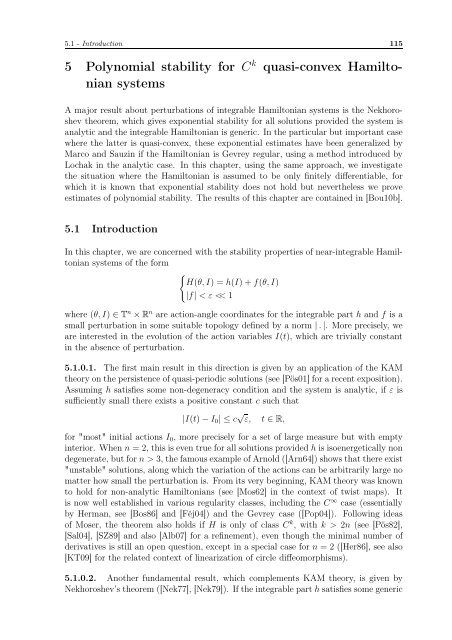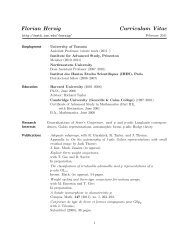PhD thesis - IAS
PhD thesis - IAS
PhD thesis - IAS
You also want an ePaper? Increase the reach of your titles
YUMPU automatically turns print PDFs into web optimized ePapers that Google loves.
5.1 - Introduction 115<br />
5 Polynomial stability for C k quasi-convex Hamiltonian<br />
systems<br />
A major result about perturbations of integrable Hamiltonian systems is the Nekhoroshev<br />
theorem, which gives exponential stability for all solutions provided the system is<br />
analytic and the integrable Hamiltonian is generic. In the particular but important case<br />
where the latter is quasi-convex, these exponential estimates have been generalized by<br />
Marco and Sauzin if the Hamiltonian is Gevrey regular, using a method introduced by<br />
Lochak in the analytic case. In this chapter, using the same approach, we investigate<br />
the situation where the Hamiltonian is assumed to be only finitely differentiable, for<br />
which it is known that exponential stability does not hold but nevertheless we prove<br />
estimates of polynomial stability. The results of this chapter are contained in [Bou10b].<br />
5.1 Introduction<br />
In this chapter, we are concerned with the stability properties of near-integrable Hamiltonian<br />
systems of the form<br />
<br />
H(θ, I) = h(I) + f(θ, I)<br />
|f| < ε 3, the famous example of Arnold ([Arn64]) shows that there exist<br />
"unstable" solutions, along which the variation of the actions can be arbitrarily large no<br />
matter how small the perturbation is. From its very beginning, KAM theory was known<br />
to hold for non-analytic Hamiltonians (see [Mos62] in the context of twist maps). It<br />
is now well established in various regularity classes, including the C ∞ case (essentially<br />
by Herman, see [Bos86] and [Féj04]) and the Gevrey case ([Pop04]). Following ideas<br />
of Moser, the theorem also holds if H is only of class C k , with k > 2n (see [Pös82],<br />
[Sal04], [SZ89] and also [Alb07] for a refinement), even though the minimal number of<br />
derivatives is still an open question, except in a special case for n = 2 ([Her86], see also<br />
[KT09] for the related context of linearization of circle diffeomorphisms).<br />
5.1.0.2. Another fundamental result, which complements KAM theory, is given by<br />
Nekhoroshev’s theorem ([Nek77], [Nek79]). If the integrable part h satisfies some generic



